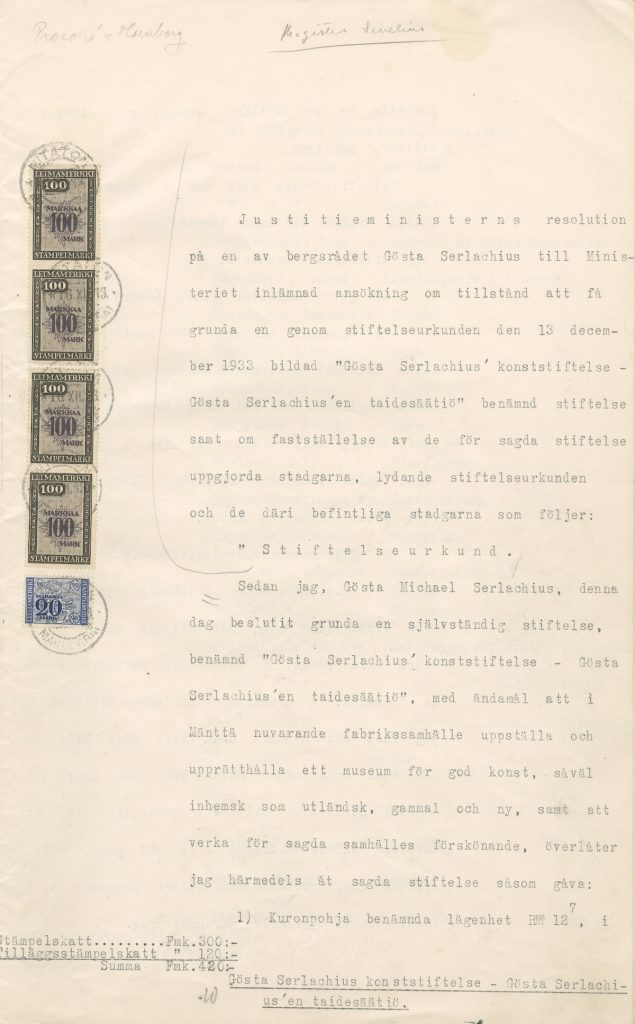Gösta Serlachius Fine Arts Foundation celebrates its 90th anniversary since its foundation
DECEMBER 2023
The charter of the Gösta Serlachius Fine Arts Foundation was approved by the Ministry of Justice on 15 December 1933. However, the plans for the art museum involved many twists and turns that could have taken Serlachius’ art collection to Helsinki as well.
The foundation had been established after a period of less than twenty years, during which CEO Gösta Serlachius was actively increasing his art collection and considering its display. In his memoirs, Serlachius has described one significant moment.
In September 1916, he was travelling with architect Walter Thomé on a train north of Stockholm and got hold of the newspaper Hufvudstadsbladet at one of the northern stations. It carried an announcement of the establishment of a limited liability company, the aim of which was to acquire a modern exhibition apartment for the visual arts in Helsinki.
This was a moment of excitement and realization, which Serlachius described: “I wanted to donate funds to a project like this, and I got so excited in my thoughts that I couldn’t wait to let Walter Thomé sleep, but woke him up to inform him of my idea.”
Before this, a tragedy had occurred in the life of Gösta Serlachius, the death of his youngest child, which was soon followed by a divorce. Art brought content and comfort to his life, and his good financial situation gave him the opportunity to increase his art collection. Serlachius paved the way for the collection to move to the capital by exhibiting it at the Ateneum art museum in 1919.
The estimated cost of building the Kunsthalle was FIM 170,000, which Serlachius thought he could pay. However, the building plans were postponed due to the turbulent years of 1917 and 1918, and before the drawings were received for Kunsthalle Helsinki, it was already 1920. The costs multiplied, and in the 1920s began the depression that affected Serlachius’ economy. Construction was postponed further, and in the end the Serlachius Kunsthalle was not built in Helsinki.
The newspapers reported that Serlachius had not kept his promises, even though he contributed to the construction costs of Kunsthalle Helsinki, completed in 1928. Serlachius was so offended by this public criticism that he did not visit Kunsthalle Helsinki for years, even though he worked closely with Bertel Hintze, who was hired as its chief curator. Serlachius turned his back on the capital and hired Hintze to design an art museum and foundation in Mänttä.
The Gösta Serlachius Fine Arts Foundation was established to build a museum for good domestic and foreign art. The beautification of Mänttä was also recorded as a goal. Serlachius had requested architect Jarl Eklund for the museum’s drawings already before the foundation was established and continued to design with him throughout the 1930s.
After the cooperation soured, the work was continued by architect Toivo Anttila and in the last phase by architect Uno Ullberg, who designed the Vyborg Art Museum. Serlachius had ensured the foundation’s ability to function and the possibility of building a museum by donating not only artworks but also a considerable amount of Serlachius company’s shares as well as some land.
The war and the death of Gösta Serlachius in 1942 interrupted the plans, but R. Erik Serlachius, who became chairman of the foundation, solved the museum question in a practical way by opening a museum at Joenniemi Manor in 1945. At the same time, the negative effects of settlement activities and taxation on the future of Joenniemi were avoided. G. A. Serlachius Oy’s librarian Lasse Sevelius was hired for practical museum work.
Helena Hänninen
Curator



